Decor
10 Interior House Design Mistakes to Avoid
Lose the design blunders and unlock the secrets to crafting a captivating home ambiance.
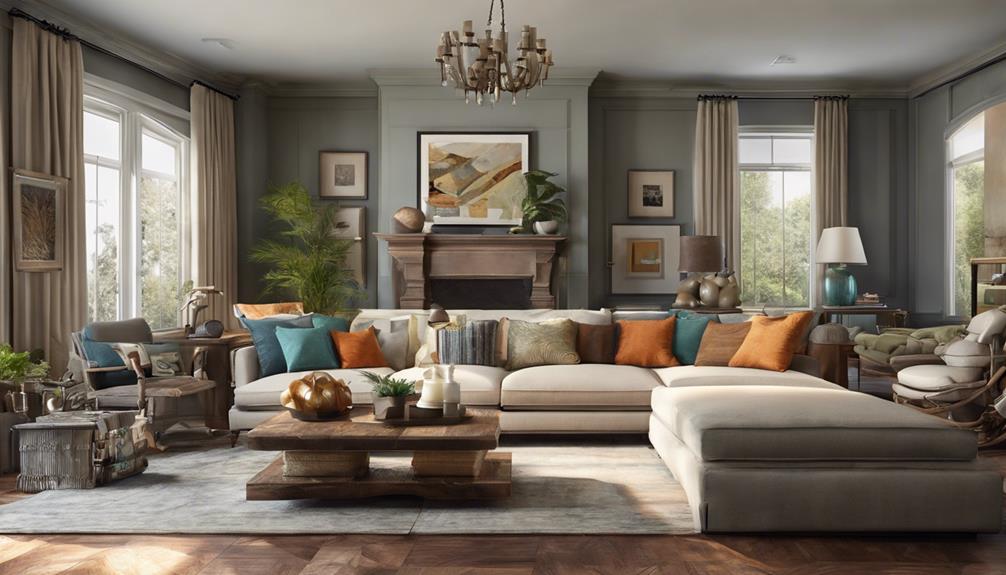
As we navigate the labyrinth of interior house design, it's crucial to steer clear of pitfalls that can hinder the harmony and functionality of our living spaces. Each decision we make, from the paint colors to the furniture layout, plays a significant role in shaping the ambiance of our homes.
By sidestepping these common design missteps, we can cultivate an environment that not only pleases the eye but also nurtures our well-being. Let's explore the nuances of creating a space that truly feels like home.
Key Takeaways
- Choose paint colors wisely to set the right ambiance.
- Arrange furniture strategically for a functional and cohesive layout.
- Design open spaces with proper furniture proportions and focal points.
- Plan traffic flow and functional zones for a well-utilized and visually appealing space.
Wrong Paint Colors
Choosing the wrong paint color for your walls can completely alter the feel and vibe of a room, making it important to take into account color psychology and lighting effects during the selection process.
The paint color you select sets the mood and ambiance of the space, guaranteeing how you feel when you enter. Color psychology guides us in understanding how different hues can impact emotions and behaviors.
When testing paint swabs on the wall, make sure how natural and artificial light sources interact with the color throughout the day. Opting for a neutral base color provides a versatile backdrop, making for easy changes in decor and furniture.
Take cues from your existing furniture when selecting paint colors to guarantee a cohesive look. Harmonizing wall colors with the tones in your furnishings can create a balanced and inviting atmosphere.
Cluttered Room Layout
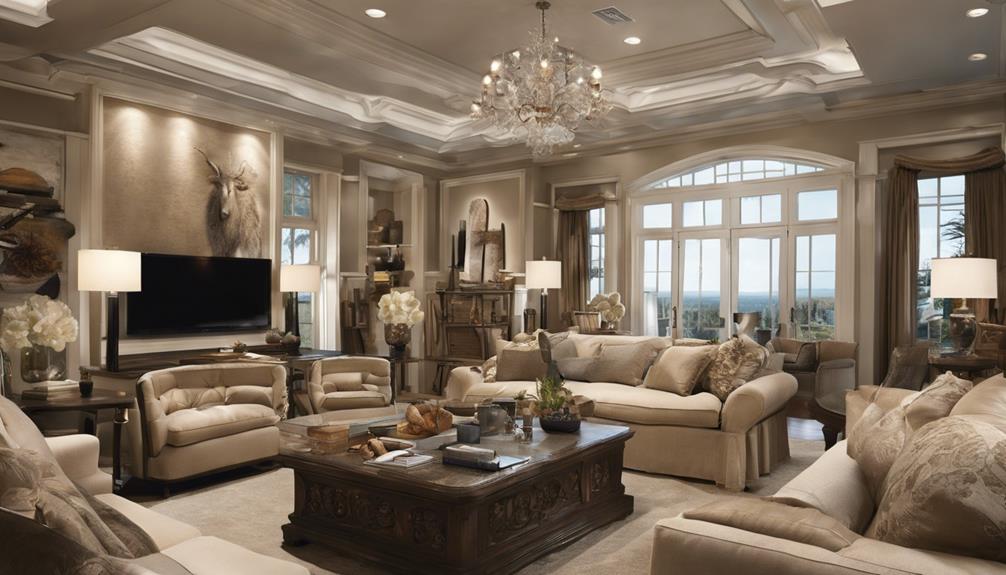
Let's talk about how the way we arrange our furniture can have a big impact on the feel of a room.
When furniture is crammed together, it can create a sense of chaos and make the space feel overwhelming.
Optimal Furniture Arrangement
Arranging furniture in a cluttered room can greatly impact the visual appeal and functionality of the space. When optimizing furniture arrangement, consider these key points:
- Avoid pushing all furniture against the walls; create a more inviting and dynamic layout.
- Vary furniture heights and mix shapes to add visual interest and elevate the room's aesthetics.
- Incorporate conversational furniture placement to foster intimate seating arrangements and enhance the flow of the space.
Functional Flow Design
Navigating through a cluttered room can be a frustrating experience, highlighting the importance of functional flow design in optimizing both aesthetics and practicality.
Interior design isn't just about looks; it's about how the space works for you. Cluttered room layouts hinder the room's functionality, making it challenging to move around freely.
To combat this, focus on open spaces and strategic furniture placement. Keep pathways clear to guarantee seamless movement. Smart storage solutions are key to maintaining an organized space.
Open Space Utilization
Moving from a cluttered room layout to an open space requires strategic furniture placement and thoughtful design to guarantee both functionality and visual appeal are optimized. When aiming for proper space utilization, make sure clear walkways and balanced furniture sizes to create an airy atmosphere.
To achieve a harmonious room layout, incorporate a mix of small and large furniture pieces. This approach not only enhances the aesthetic appeal but also maximizes the available space, making the room feel more spacious and inviting.
Oversized or Undersized Furniture

Let's talk about the importance of furniture proportions and functional space planning in interior design.
Oversized pieces can overwhelm a room, while undersized ones can leave it feeling empty and lacking in purpose.
Furniture Proportions
When furnishing a room, ensuring the right proportions of furniture is vital to achieving a balanced and functional space. Improper furniture proportions, whether oversized or undersized, can disrupt the visual balance and harmony of a room. To create a harmonious space, consider the following:
- Oversized furniture can overwhelm a room, disrupting the room scale and making it feel cramped.
- Undersized furniture may leave a room feeling incomplete and lacking functionality.
- Balancing furniture sizes in relation to the room's dimensions and existing pieces is important for a cohesive design.
Functional Space Planning
To guarantee a harmonious and functional room design, attention to functional space planning regarding oversized or undersized furniture is pivotal. Properly scaled furniture is vital for creating a balanced and functional space that maximizes comfort and aesthetics. When considering furniture sizes, take into account the room dimensions and layout to avoid overpowering or underwhelming the space. Balancing furniture sizes is key to establishing a harmonious environment that promotes ease of movement and a cohesive design aesthetic. A well-thought-out furniture layout contributes greatly to a balanced and functional space. Ensuring that each piece of furniture fits seamlessly within the room not only enhances its functionality but also elevates the overall appeal of the space.
| Furniture Sizes | Room Dimensions | Properly Scaled Furniture |
|---|---|---|
| Consider proportions to avoid overcrowding or empty spaces | Take into account the size of the room when selecting furniture | Optimal use of space enhances functionality and aesthetics |
| Room Layout | Harmonious Environment | Balanced Furniture Layout |
| Arrange furniture to promote ease of movement | Create a visually appealing space | Ensure a cohesive and functional design aesthetic |
Inadequate Lighting
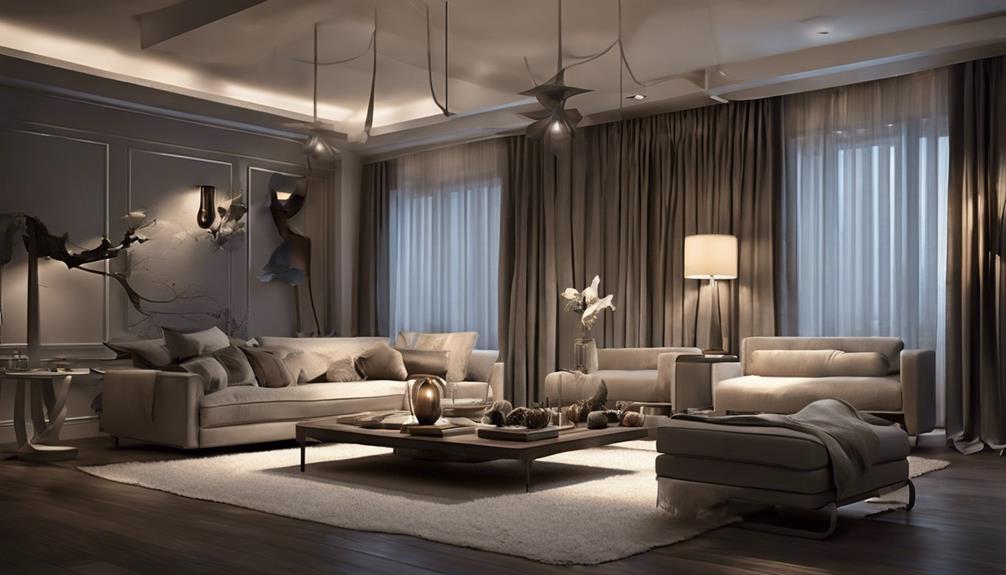
Insufficient lighting can profoundly impact the atmosphere and functionality of a room, creating a space that feels dull and uninviting. When considering lighting in interior design, it's crucial to remember that different types of lighting serve various purposes.
- Multiple Lighting Sources: Integrating ambient, task, and accent lighting can enhance the overall design and functionality of a room.
- Fixture Selection: Choosing the right lighting fixtures can greatly alter the perception of colors and textures within a space.
- Professional Guidance: Hiring a professional lighting designer can help optimize the lighting layout for best results, ensuring that every corner is well-lit and visually appealing.
Neglecting Vertical Space
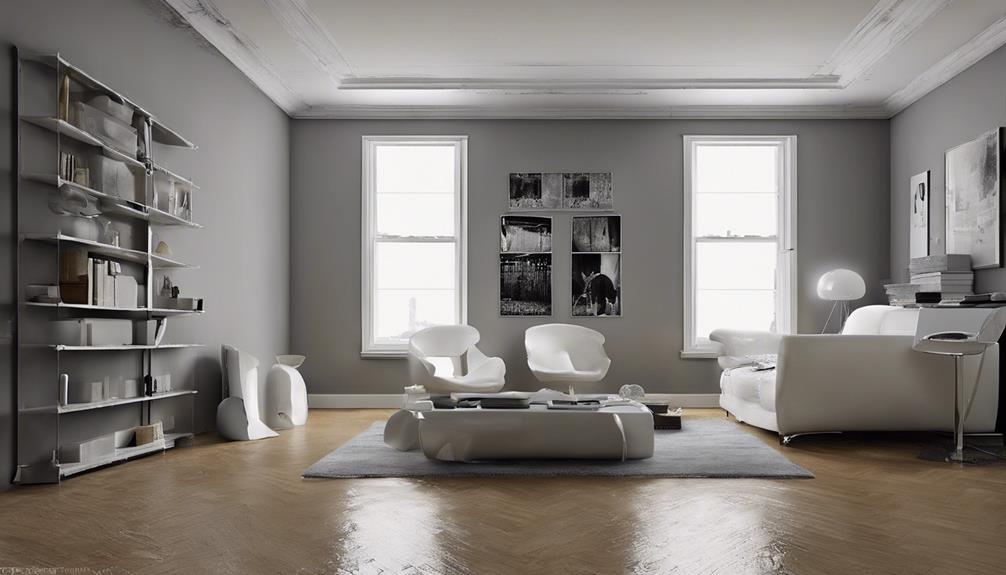
Neglecting vertical space in interior design can result in missed opportunities to enhance the overall aesthetics and functionality of a room. To maximize the potential of vertical space, consider incorporating tall furniture pieces, such as bookcases or floor-to-ceiling cabinets, that not only provide storage but also draw the eye upwards. Pendant lighting fixtures or hanging plants can add a sense of height and visual interest to the room. Mirrors strategically placed on walls or ceilings can create the illusion of a larger space, making the room feel more open and airy. Artwork or wall decals can be used to accentuate vertical lines, adding depth and character to the room. By utilizing vertical space effectively, you can transform a room from feeling cramped and dull to spacious and dynamic.
| Vertical Space Utilization | Tall Furniture Pieces | Accentuate Vertical Lines |
|---|---|---|
| Pendant Lighting Fixtures | Hanging Plants | Mirrors on Walls |
| Artwork |
Lack of Design Variety
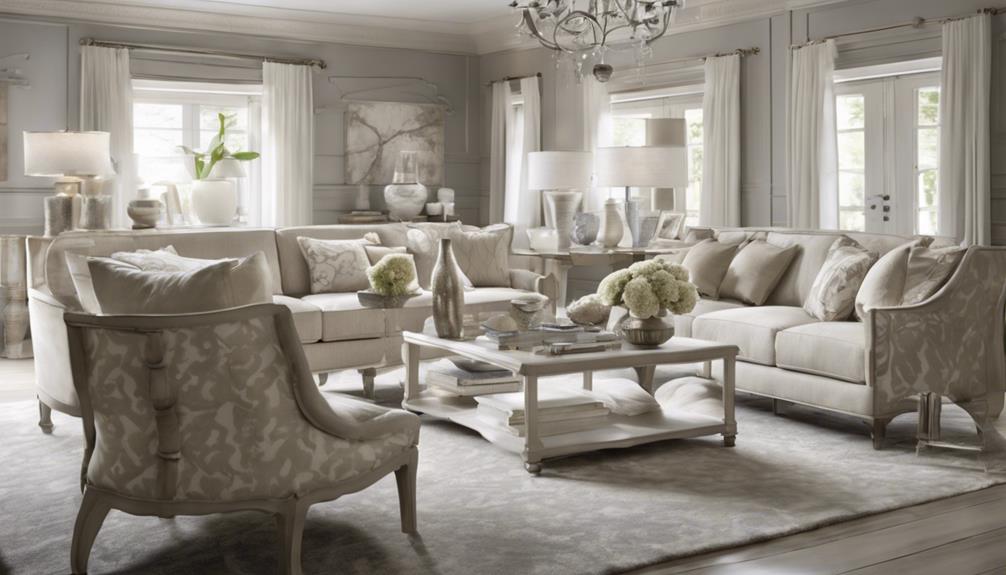
Diversifying design elements within a space is key to creating a visually intriguing and dynamic interior. When it comes to interior design, mixing furniture finishes, colors, textures, and materials adds depth and dimension, elevating the overall aesthetic of the room.
By incorporating various elements such as artwork and lighting fixtures, you can enhance the visual appeal and create a more engaging atmosphere. Avoiding a single color scheme by layering neutrals with warm tones and accessories can prevent the space from feeling flat and one-dimensional.
Embracing design variety not only adds interest to your home but also guarantees that your interior is memorable and unique. Remember, a lack of diversity in design can lead to a monotonous and uninspiring space, so don't be afraid to experiment and combine different elements to achieve a truly enthralling interior aesthetic.
Absence of Focal Point

Lacking a central focal point in a room can result in a visually unbalanced and uninspiring interior design. A focal point serves as the anchor of the space, drawing the eye and creating visual interest. It can be a large piece of artwork, a striking fireplace, or a statement furniture item. Without a focal point, a room may feel incomplete and lack character, leaving the design looking haphazard and disconnected. Designing around a focal point helps tie everything together, creating a cohesive look that elevates the entire room's aesthetic.
| Importance of Focal Point | ||
|---|---|---|
| Draws attention | Creates visual interest | Anchors the space |
| Elevates design | Enhances interior | Fosters a cohesive look |
Poor Traffic Flow Planning
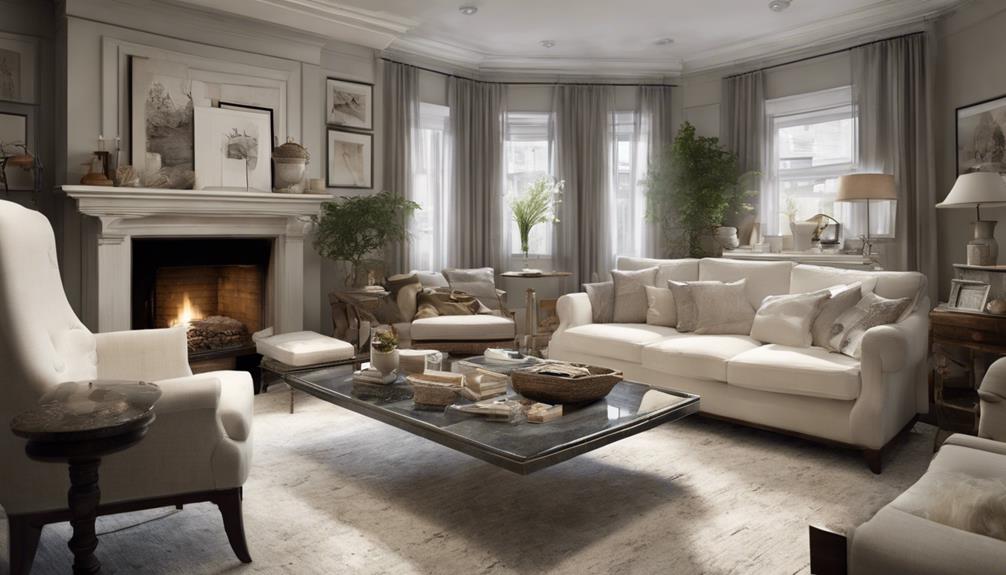
Let's talk about the critical aspects of poor traffic flow planning in interior house design.
Furniture placement errors, cluttered pathways, and a lack of functional zones can disrupt the flow and functionality of a space.
Ensuring clear walkways and strategic furniture placement are key to creating a harmonious layout that allows for comfortable movement.
Furniture Placement Errors
Have you ever wandered through a room feeling like the furniture layout was hindering your movements, creating obstacles at every turn? Poor furniture placement can disrupt traffic flow, leading to congested spaces and hindering functionality.
When furniture is arranged incorrectly, it not only affects the visual balance of the room but also impacts the overall usability of the space. To avoid these issues, it's vital to plan the traffic flow within a room carefully. By strategically positioning furniture, you can guarantee space usage, key a harmonious environment, and create a welcoming atmosphere. Consider these points:
- Traffic flow planning is key for a user-friendly space.
- Incorrect furniture arrangement can disrupt visual balance.
- Strategic furniture positioning enhances functionality and space optimization.
Cluttered Pathways
Navigating through a home should feel effortless, with clear pathways inviting seamless movement and unhindered exploration of each space. Cluttered pathways disrupt visual flow, leading to congestion and making it challenging to move around comfortably. Proper traffic flow planning involves strategic furniture placement and keeping walkways clear to guarantee a harmonious environment. By optimizing traffic flow, you can enhance the functionality of each room and create a more welcoming atmosphere. Check out the table below for a quick overview of how cluttered pathways affect the overall visual flow in your home:
| Effects of Cluttered Pathways |
|---|
| Disrupt visual flow |
| Hinder easy navigation |
| Create congestion |
| Compromise comfort |
| Impede seamless movement |
Lack of Functional Zones
Clear pathways not only enhance visual flow and comfort but also play an important role in facilitating seamless movement throughout a home, ensuring efficient use of space and creating designated functional zones for specific activities. When designing a house, overlooking functional zones can lead to congestion and a lack of usability. Strategic placement of furniture and barriers can have a major impact on traffic flow, making navigation within the space more intuitive and enjoyable.
By identifying high-traffic areas and implementing functional zones, you can enhance the overall usability of your home. Consider the following to improve your home's traffic flow:
- Analyze high-traffic areas to create designated functional zones.
- Optimize furniture placement to improve traffic flow and usability.
- Remove barriers that obstruct movement between different areas.
Outdated Furniture and Decor
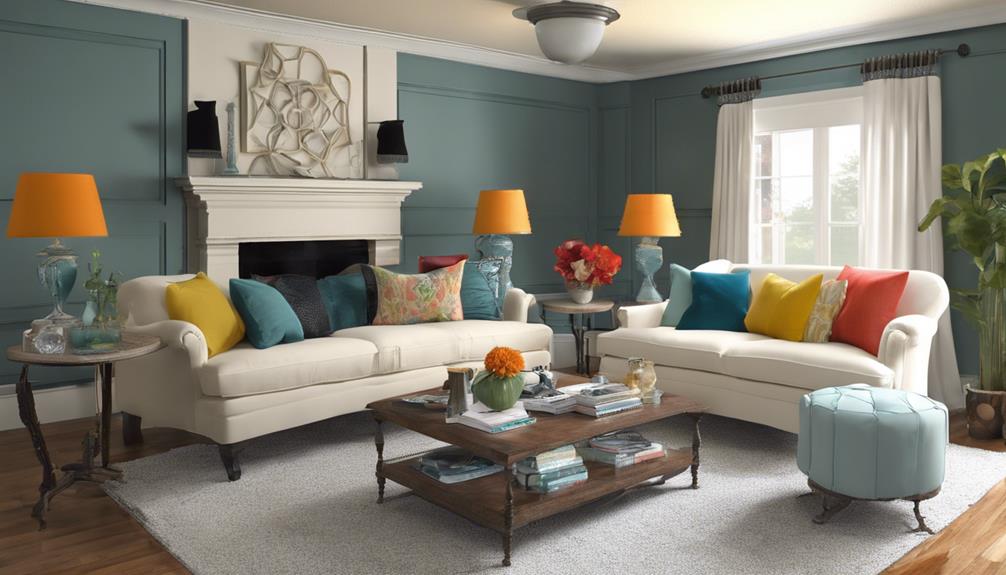
Reviving your space by updating outdated furniture and decor can instantly transform the aesthetic and style of a room. Outdated furniture has the potential to disturb the overall visual appeal of your living space. To breathe new life into your interiors, consider incorporating modern decor elements.
Mixing old furniture with contemporary pieces can create an alluring and eclectic design scheme. By updating your furniture, not only do you enhance the visual appeal of the room, but you also improve its functionality. Repurposing or refinishing old furniture can align it with a more contemporary design language, adding a touch of uniqueness to your space.
Ignoring Texture Integration
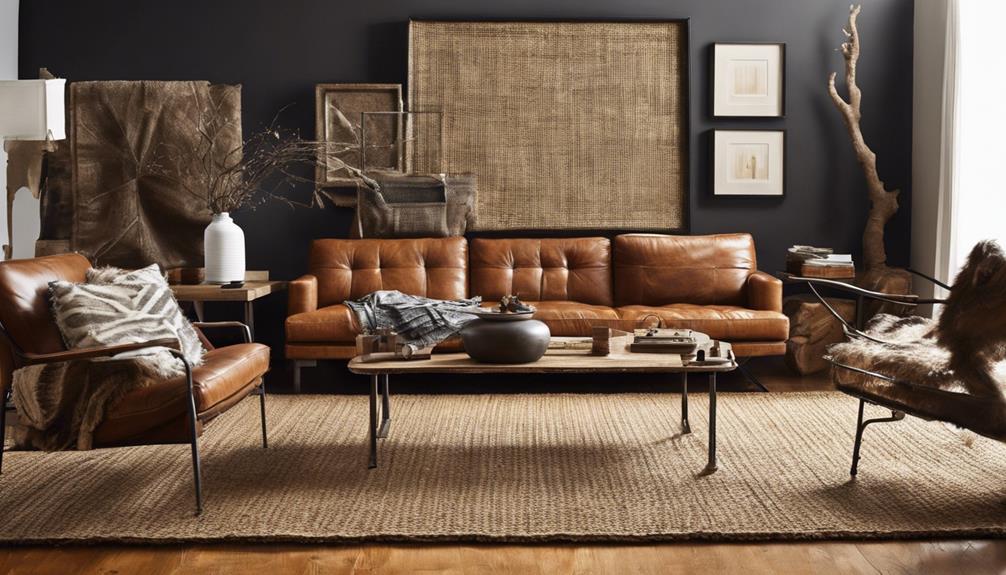
To truly elevate the ambiance of your living space, one mustn't overlook the important aspect of integrating textures seamlessly throughout the interior design. Texture integration is a key element in creating a visually appealing and dynamic interior that stimulates the senses and adds depth to the overall aesthetic.
Here are some key points to ponder:
- Visual Interest: Incorporating various textures like rough, smooth, shiny, and matte can enhance visual interest and make your space more engaging.
- Balanced Design: Mixing different textures in a harmonious way can contribute to a balanced design, ensuring that no single texture overwhelms the space.
- Tactile Experience: Introducing textures through elements such as rugs, curtains, upholstery, and decorative accessories can create a tactile experience that adds warmth and character to the room.
Frequently Asked Questions
What Are the 7 Rules of Interior Design?
We believe the 7 rules of interior design are balance, emphasis, rhythm, unity, contrast, scale, and proportion. These principles guide us in creating visually appealing spaces that are harmonious, engaging, and cohesive.
What Is Bad Design in Interior Design?
We see bad design in interior design as a lack of flow, functionality, and balance. Inappropriate furniture placement, wrong rug sizes, and poor lighting choices can all contribute. Failing to create a focal point or consider traffic flow are common mistakes.
What Is the 60 40 Rule in Interior Design?
We apply the 60/40 rule in interior design to create a balanced color scheme. It involves using 60% dominant color and 40% secondary color for harmony. This technique secures our space feels cohesive and visually appealing.
What's the Golden Rule Most Interior Designers Follow?
At eye level, we place art like a spotlight on a stage, creating balance and drawing focus in a room. This golden rule guides designers to craft spaces that captivate and inspire occupants.
Conclusion
So, as we wrap up our discussion on interior house design mistakes to avoid, it's important to remember that everyone's style and preferences are unique.
While it's essential to pay attention to key design principles, don't be afraid to inject your personality into your space.
Remember, your home should be a reflection of who you are, so trust your instincts and create a space that makes you happy.
After all, your home is where your heart is.
- About the Author
- Latest Posts
Introducing Ron, the home decor aficionado at ByRetreat, whose passion for creating beautiful and inviting spaces is at the heart of his work. With his deep knowledge of home decor and his innate sense of style, Ron brings a wealth of expertise and a keen eye for detail to the ByRetreat team.
Ron’s love for home decor goes beyond aesthetics; he understands that our surroundings play a significant role in our overall well-being and productivity. With this in mind, Ron is dedicated to transforming remote workspaces into havens of comfort, functionality, and beauty.
Decor
Master Antiquing With Chalk Paint in 5 Steps
Start your journey to mastering antiquing with chalk paint in 5 steps and transform your furniture into vintage treasures.
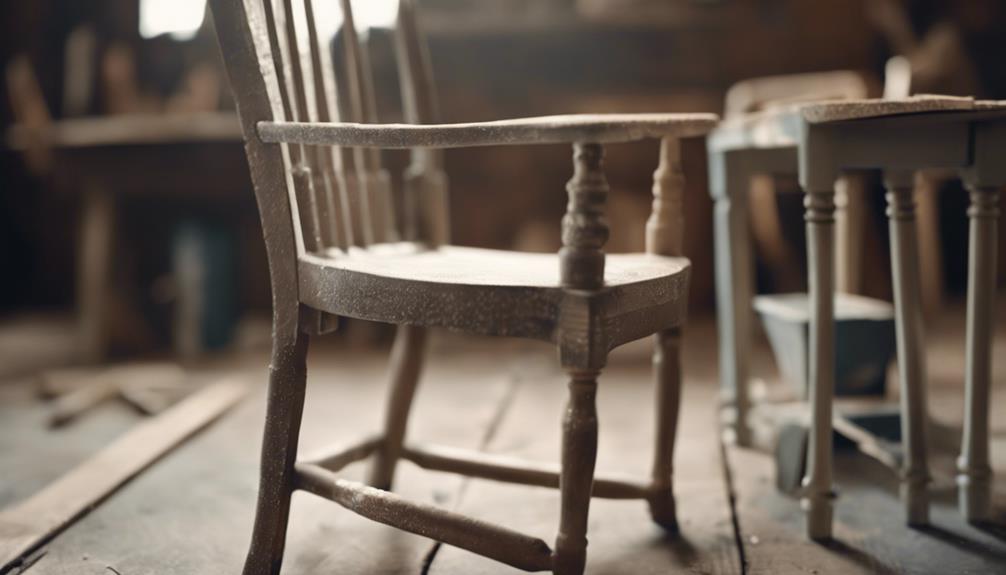
Master antiquing with chalk paint in 5 steps involves thorough surface cleaning, applying chalk paint in thin coats, distressing for a vintage look, sealing with a wax or polyurethane finish, and exploring different distressing techniques. Prepare by cleaning and sanding the surface, then choose high-quality paint and brushes for application. Experiment with dry and wet distressing, and seal the finish to protect against chipping and fading. For unique finishes, mix distressing methods and select the right sealant based on desired outcome. Mastering chalk paint antiquing takes practice and attention to detail, ensuring a beautifully aged furniture look.
Key Takeaways
- Choose high-quality chalk paint for best results.
- Apply thin, even coats for a smooth finish.
- Experiment with distressing techniques like dry or wet distress.
- Seal the finish with wax or polyurethane for durability.
- Practice and refine distressing skills for a masterful antique look.
Preparation
Before distressing furniture with chalk paint, we make sure to thoroughly clean the surface and lightly sand any rough spots for a smoother finish. This step is essential in achieving a professional-looking result.
Cleaning the furniture surface with White Lightning or TSP Degreaser helps remove any dirt, grease, or other contaminants that could interfere with the adhesion of the chalk paint. Using a lint-free cloth ensures that the surface is free of any residue that could affect the paint application.
Additionally, lightly sanding the furniture helps create a clean and smooth surface for the chalk paint to adhere to evenly. This process also helps remove any existing imperfections, ensuring a flawless final result.
Proper preparation sets the foundation for successful distressing with chalk paint, allowing for a more authentic and aged appearance.
After distressing, sealing the piece with a clear wax coat will protect the finish and enhance the overall look of the furniture.
Applying Chalk Paint
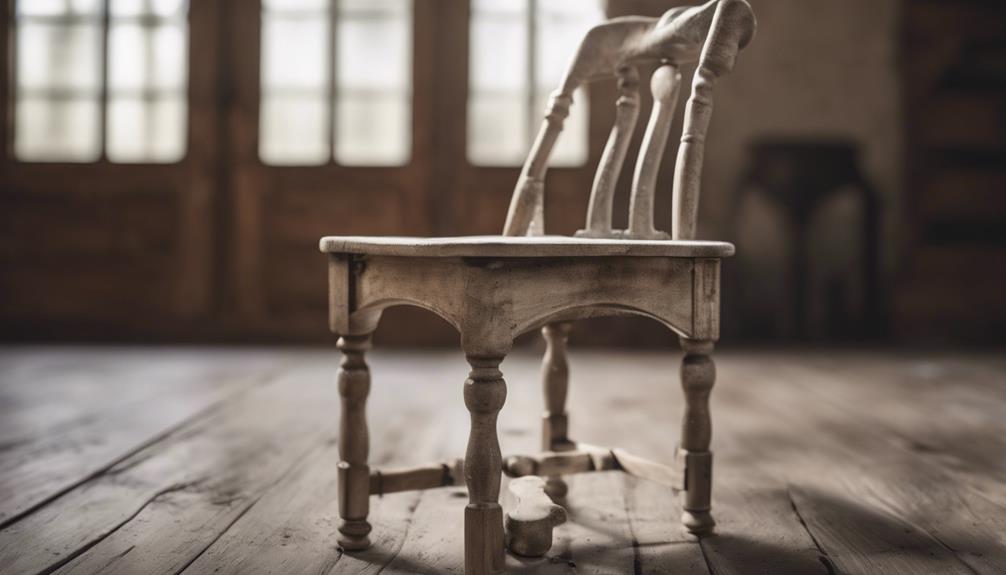
To achieve a professional finish with chalk paint, we recommend selecting a high-quality paint suitable for the specific furniture type.
When applying chalk paint, it's important to do so in thin coats to guarantee even application. Utilizing chalk paint brushes can help achieve better control and coverage.
It's vital to allow each coat of chalk paint to dry completely before applying the next one. This process helps prevent smudging and promotes a consistent finish.
Additionally, when starting a project, make sure you have enough chalk paint, typically a quart for larger pieces, to maintain color consistency throughout the furniture item.
Distressing Techniques
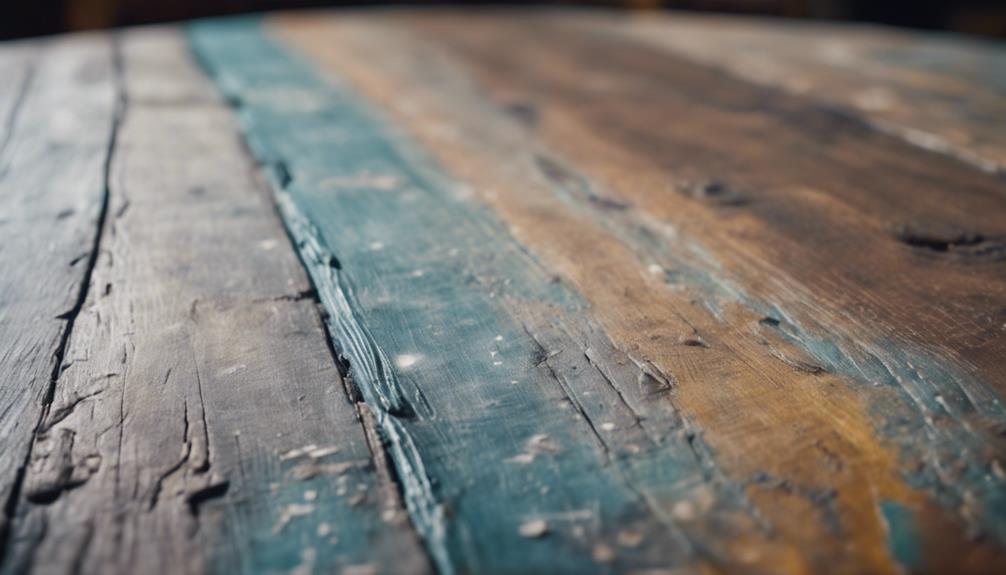
We can achieve various vintage looks by using different distressing techniques with chalk paint. Dry distress involves lightly sanding the chalk paint to reveal the underlying layers, creating a weathered appearance reminiscent of aged furniture.
On the other hand, wet distress requires wiping the chalk paint with a damp cloth to achieve a more natural, worn look. Wax distress, also known as the resist technique, utilizes wax as a barrier to create a subtle distressed effect on the furniture, adding depth and character to the piece.
Each distressing method offers a unique finish, allowing for experimentation and customization to achieve an authentic antique appearance. By trying out different distressing techniques, individuals can discover the method that best suits their desired vintage look.
Whether it's through sanding, wax resist, wet distress, or a combination of these methods, chalk paint provides a versatile medium for creating distinctive and aged finishes on furniture pieces.
Sealing the Finish

For achieving a durable and long-lasting distressed finish on furniture painted with chalk paint, selecting a high-quality clear wax or polyurethane sealant is essential. Applying a protective layer of sealant is vital to preserve the distressed look and prevent chipping or fading of the paint. It is recommended to apply the sealant in even coats to guarantee a smooth and lasting finish. Here is a comparison table to help you choose between wax and polyurethane sealants for your distressed furniture:
| Criteria | Wax Sealant | Polyurethane Sealant |
|---|---|---|
| Finish | Matte or Satin Finish | Glossy or Satin Finish |
| Durability | Requires Reapplication Over Time | Long-lasting and Durable |
| Application Ease | Easy to Apply, Buffing Required | Requires Thorough Application |
Both wax and polyurethane sealants offer protection and enhancement to your chalk-painted distressed furniture. Select the one that best suits your desired finish and maintenance preferences.
Chalk Paint Distressing Tips

Let's explore effective techniques for distressing chalk paint to achieve a vintage and worn look on furniture surfaces.
When aiming for a customized distressed finish, there are various distressing methods to choose from. Dry distress involves lightly sanding the chalk paint to reveal the base color underneath, offering a classic vintage appearance.
On the other hand, the wet distress technique includes wiping off the chalk paint with a damp cloth to create a natural worn effect.
For a more subtle distressed finish, consider using the wax distress or resist technique by applying wax to protect certain areas from paint.
Remember to protect the paint and preserve the finish by sealing distressed furniture with wax or polyurethane.
Frequently Asked Questions
How to Get an Antique Look With Chalk Paint?
To achieve an antique look with chalk paint, consider distressing techniques like dry distressing, wet distressing, or wax distress.
Dry distressing involves light sanding for a vintage appearance.
Wet distressing requires wiping the paint with a damp cloth for a natural worn look.
Wax distress, or resist technique, can create a subtle distressed effect on furniture.
Sealing the distressed piece with clear wax or polyurethane is essential to protect the finish and maintain the antique aesthetic.
How to Make Furniture Look Distressed With Chalk Paint?
To make furniture look distressed with chalk paint, we can use various techniques. Dry distressing involves lightly sanding the surface to reveal the base layer, creating a vintage effect.
Wet distressing entails wiping the paint with a damp cloth to expose the underlying color, achieving a natural worn look.
Wax distressing, known as the resist technique, uses wax to create a subtle distressed effect.
These methods offer unique ways to customize and achieve a distressed look with chalk paint.
How Do You Chalk Paint Step by Step?
We begin chalk painting by cleaning and lightly sanding the furniture surface.
Next, select a high-quality chalk paint and apply it in thin, even coats.
Explore different distressing methods such as dry, wet, or wax distress.
Finally, seal the distressed furniture with clear wax or polyurethane for protection.
Following these steps attentively guarantees a successful chalk painting project with a beautifully antiqued finish.
Do I Distress or Wax First?
We recommend distressing before waxing when working with chalk paint for an authentic aged appearance. Distressing creates texture and depth, enhancing the final antique effect once sealed with wax.
Applying wax over distressed areas not only protects the finish but also accentuates the distressed look. Waxing before distressing can complicate the process as the wax may interfere with sanding.
Distressing first allows for better control over the furniture's final appearance.
Conclusion
To sum up, mastering antiquing with chalk paint is a fulfilling process that can transform ordinary furniture into stunning pieces with character and charm.
As the saying goes, 'A piece of furniture is like a blank canvas waiting to be brought to life.'
By following these 5 steps, you can discover the full potential of chalk paint and create unique and beautiful pieces that will stand the test of time.
Happy antiquing!
- About the Author
- Latest Posts
Introducing Ron, the home decor aficionado at ByRetreat, whose passion for creating beautiful and inviting spaces is at the heart of his work. With his deep knowledge of home decor and his innate sense of style, Ron brings a wealth of expertise and a keen eye for detail to the ByRetreat team.
Ron’s love for home decor goes beyond aesthetics; he understands that our surroundings play a significant role in our overall well-being and productivity. With this in mind, Ron is dedicated to transforming remote workspaces into havens of comfort, functionality, and beauty.
Decor
10 Steps to Painting a Plastic Frame
Uncover professional tips for transforming plastic frames with paint, ensuring a flawless finish and lasting results.
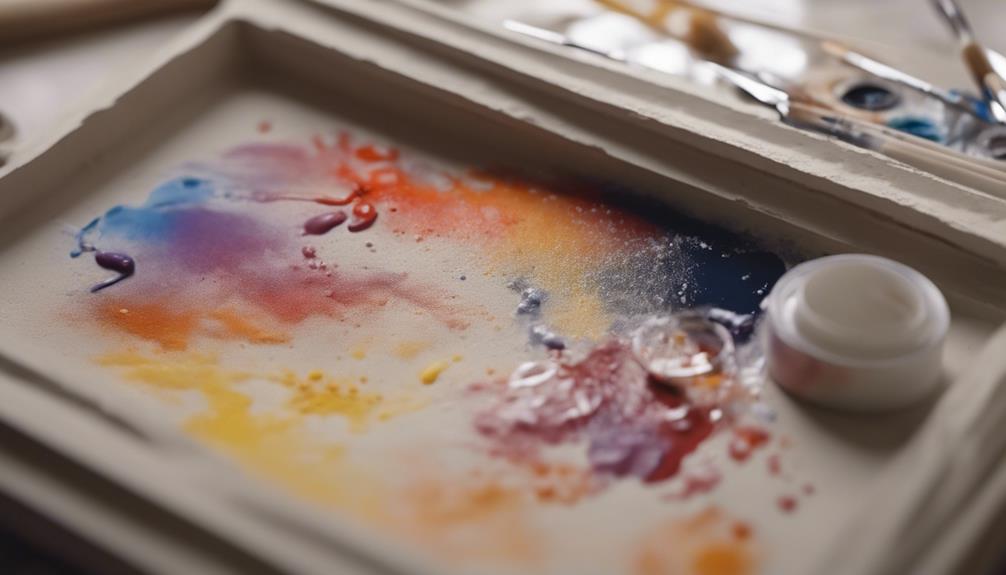
To paint a plastic frame effectively, start by selecting polypropylene or polyethylene frames. Clean thoroughly and lightly sand before applying a suitable primer. Use rubbing alcohol for a smooth finish, then mask off areas and apply even coats of paint with proper drying time. Add creative touches and seal with polyurethane for protection. This process guarantees a professional-looking result that lasts.
Key Takeaways
- Select plastic frames suitable for painting, avoiding PVC or polystyrene.
- Thoroughly clean and lightly sand the frame for adhesion.
- Apply a plastic-specific primer evenly after surface prep.
- Use painter's tape for clean lines and masking off.
- Seal with polyurethane for protection and finish longevity.
Selecting the Right Plastic Frame
When selecting a plastic frame for painting, make sure it's made of suitable materials like polypropylene or polyethylene for better paint adhesion. Different plastics have varying levels of compatibility with paint, so it's important to choose the right type to achieve best results.
Avoid using frames made of polyvinyl chloride (PVC) or polystyrene, as these materials may not allow the paint to adhere effectively, leading to peeling or flaking over time.
Certain types of paint may also work better with specific plastic frames. Checking the manufacturer's recommendations for the frame can provide valuable insights into which paints are most suitable for that particular material.
Opting for plastic frames specifically designed for painting can ensure a smoother process and a more professional finish.
Cleaning and Sanding the Surface

How should we prepare the plastic frame surface before painting to guarantee excellent adhesion and a smooth finish? To guarantee a successful paint job, follow these steps:
- Cleaning:
Begin by thoroughly cleaning the plastic frame to remove any dirt, dust, or grime. This step is vital as any impurities on the surface can affect the adhesion of the paint.
- Sanding:
Lightly sand the surface of the plastic frame to create a rough texture. This roughness provides a better grip for the paint, allowing it to adhere more effectively and prevent peeling or chipping.
- Primer:
Consider applying a suitable primer after cleaning and sanding the frame. A primer helps the paint adhere better to the surface and can also aid in achieving a smoother finish.
- Masking:
Before painting, make sure to mask off any areas of the frame that you don't want to paint. This step ensures clean and precise lines, giving your project a professional look.
Wiping Down With Rubbing Alcohol

We recommend wiping down the plastic frame with rubbing alcohol to guarantee proper adhesion and a smooth finish before painting. Rubbing alcohol plays a vital role in preparing the plastic surface for painting by effectively removing any dirt, oils, or residue that could hinder paint adhesion. This step ensures that the paint adheres well to the plastic surface, reducing the risk of peeling or flaking over time. The quick evaporation of rubbing alcohol leaves behind a clean and dry surface, ready for the next steps in the painting process.
To illustrate the importance of this step, let's take a look at the table below:
| Benefits of Wiping Down with Rubbing Alcohol |
|---|
| Removes dirt, oils, and residue from the plastic surface |
| Enhances paint adhesion for a smoother finish |
| Quick evaporation leaves a clean surface ready for painting |
| Prevents peeling or flaking of the paint over time |
| Effective and efficient preparation before priming or painting |
Masking Off Areas for Painting

When masking off areas for painting a plastic frame, it's essential to use painter's tape to guarantee clean lines and edges.
Make sure to press down firmly on the tape to avoid any paint bleeding onto unwanted areas.
Carefully mask off intricate details or sensitive parts to achieve a professional finish.
Taping off Edges
To achieve clean and precise lines in your painting, carefully use painter's tape to mask off areas of the plastic frame that you don't want to paint.
Here are some essential steps to follow when taping off edges:
- Prepare the Surface: Make sure the edges are clean and dry before applying the tape to promote adhesion and prevent paint seepage.
- Apply the Tape: Gently press the painter's tape along the edges of the areas you want to protect, ensuring it adheres firmly to the surface.
- Seal the Edges: Run your finger along the edge of the tape to secure it tightly to the plastic frame and prevent any paint from bleeding through.
- Double-Check: Before painting, inspect the taped-off areas to confirm that the edges are properly sealed and that there are no gaps where paint could seep under the tape.
Taking the time to tape off the edges meticulously will result in a professional and polished finish for your painted plastic frame.
Covering Sensitive Parts
Cover delicate parts like glass or hardware with masking paper or plastic before painting the plastic frame to protect them from unwanted paint.
When working on plastic frames, it's important to use painter's tape to mask off areas that shouldn't be painted. Make sure the painter's tape is firmly pressed down to create a tight seal and prevent any paint from seeping through.
In addition to using painter's tape, consider covering sensitive components such as glass or hardware with masking paper to safeguard them during the painting process. Taking the time to accurately mask off these areas will result in clean and precise paint lines, contributing to a professional-looking finish on your plastic frame.
Properly covering these sensitive parts is essential in achieving a polished and refined appearance for your painted plastic frame.
Applying a Suitable Primer
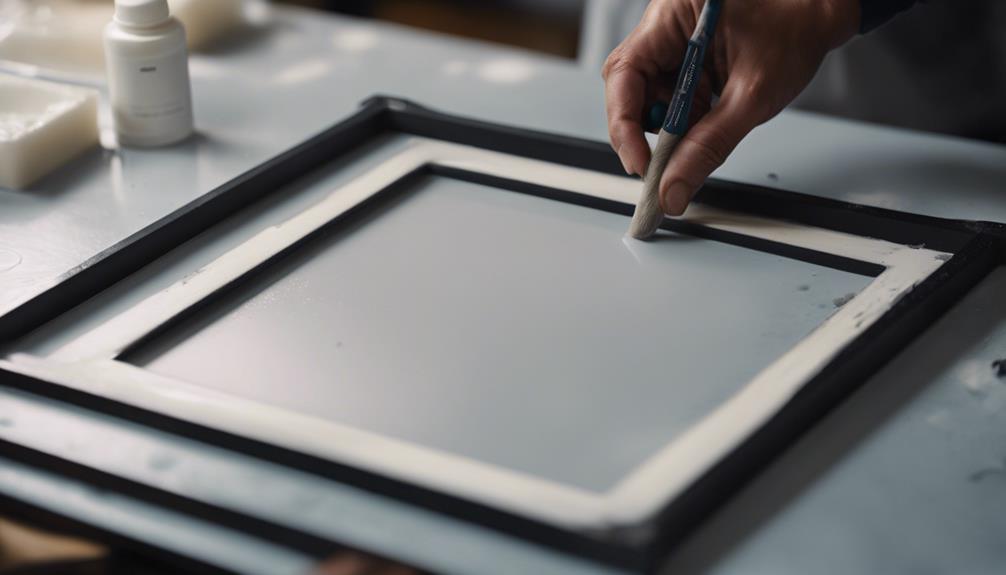
Let's kick off this step by prepping the plastic frame with a primer that's compatible with plastic surfaces. Here's what you need to know:
- Choose the Right Primer: Select a primer specifically designed for plastic frames to guarantee proper adhesion.
- Apply Evenly: Use smooth, consistent strokes to apply the primer evenly over the entire surface of the frame.
- Allow Sufficient Drying Time: Let the primer dry completely as per the manufacturer's instructions before proceeding with the next steps.
- Ensure Complete Coverage: Make sure the primer covers the plastic frame entirely to establish a strong base for the paint.
Using Appropriate Paint for Plastic

After preparing the plastic frame with a suitable primer, the next crucial step involves selecting the right paint specifically formulated for plastic surfaces.
When painting a plastic picture frame, it's vital to choose a type of paint that's designed to adhere to plastic materials. Using regular paints may result in poor adhesion, leading to peeling or chipping off easily. To guarantee a durable and long-lasting finish, opt for acrylic paint or other paints labeled for plastic surfaces. These specialized paints are formulated to bond effectively with plastic, preventing flaking and ensuring a smooth application.
Whether you prefer spray paints for a quick and even coverage or brush-on paints for more detailed work, selecting the appropriate paint for your plastic picture frame is key to achieving a professional-looking result.
Applying Even Coats of Paint
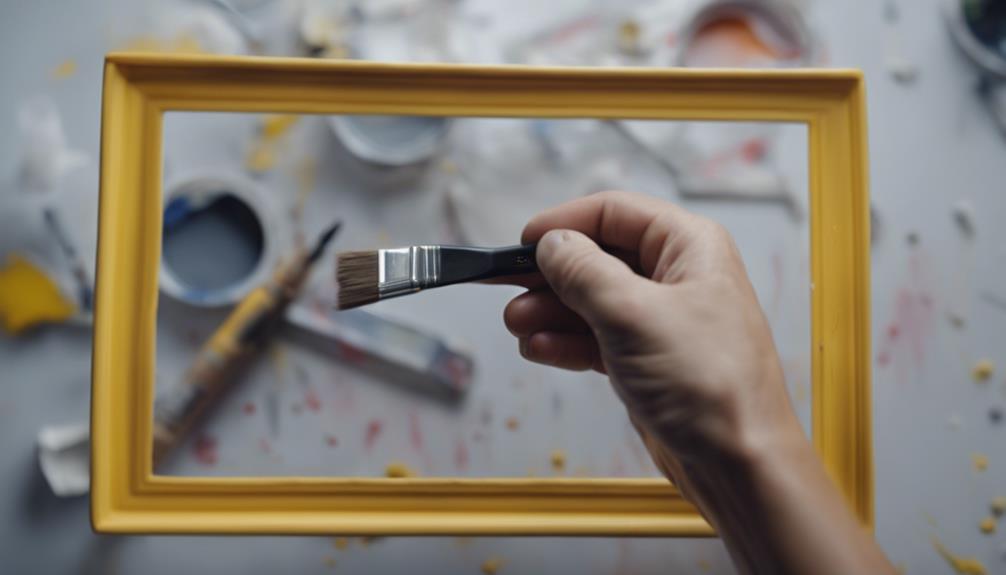
To achieve a smooth and professional finish on a plastic frame, it's essential to apply even coats of paint. When painting picture frames, following these guidelines guarantees a flawless result:
- Apply Thin and Even Coats: Each layer of paint should be applied thinly and evenly across the frame to prevent drips or uneven coverage.
- Allow Proper Drying Time: It's vital to let each coat dry before applying the next one. This helps the paint set correctly and adhere well to the plastic surface.
- Opt for Light Coats: Applying multiple light coats is preferable to a single heavy coat. This technique prevents clumping or streaking, resulting in a more uniform finish.
- Maintain Consistency: Consistency in paint application is key to achieving a uniform color and texture throughout the frame. Make sure to follow a systematic approach to ensure a professional-looking outcome.
Allowing Each Coat to Dry
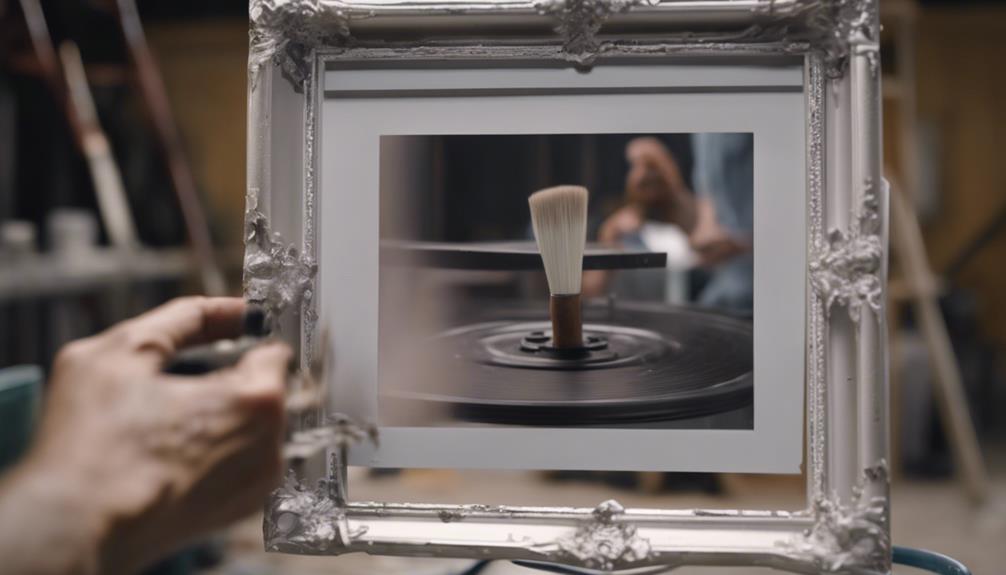
Guaranteeing that each coat of paint is thoroughly dried is a critical step in achieving a flawless finish on a plastic frame. By allowing sufficient drying time between coats, we can prevent potential issues like smudges, drips, or uneven application.
It's vital to follow the recommended drying times based on the type of paint utilized to secure the best results.
Patience for Drying Times
For best results, guaranteeing each coat of paint on the plastic frame dries thoroughly before applying the next coat is essential. Here are some key points to keep in mind:
- Prevent Smudging and Streaking: Allowing each coat to dry completely helps prevent unwanted smudges or streaks in the paint job.
- Refer to Manufacturer's Instructions: Drying times can vary depending on the type of paint used. Always refer to the manufacturer's instructions for specific guidance on drying times.
- Avoid Rushing the Process: Rushing the drying process can result in a less durable finish and potential imperfections. Patience is key for a flawless outcome.
- Achieve Professional Results: Patience during drying times ensures a smooth and professional-looking paint job on the plastic frame, leading to a high-quality and long-lasting finish.
Importance of Waiting
Allowing each coat of paint to thoroughly dry is crucial for achieving a flawless finish on a plastic frame. When painting a plastic frame, the significance of waiting between coats can't be emphasized enough.
Properly allowing each coat to dry guarantees that the paint adheres evenly, preventing issues like smudging, running, or uneven coverage. Rushing this process can lead to a less durable and professional-looking result, with potential peeling or chipping over time.
The drying time required between coats may vary depending on the type of paint being used, so it's essential to follow the specific instructions provided on the paint label. Patience is key in achieving a smooth and flawless paint job on your plastic frame.
Adding Touch-Ups and Details
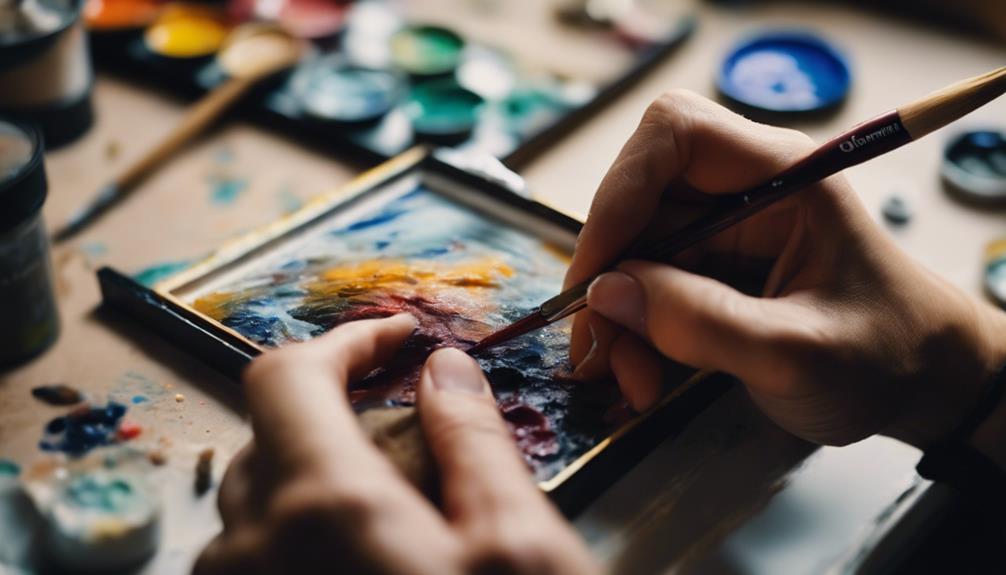
We often enhance the visual appeal of the painted plastic frame by adding intricate designs or patterns using acrylic craft paint on rubber stamps for a personalized touch.
To add that extra flair, here are some tips for detailing your plastic frame:
- Create Stencils: Make stencils from contact paper or use pre-made ones to easily incorporate decorative elements onto the frame.
- Antiqued Look: Apply acrylic paint or tinted glaze to achieve a vintage appearance, enhancing the frame's visual appeal.
- Metallic Touch: Experiment with gold or silver glaze for an elegant and luxurious finish.
- Creative Touches: Utilize stamps, painted designs, or rubbed-on color to elevate the overall aesthetic of the frame.
Sealing With Polyurethane
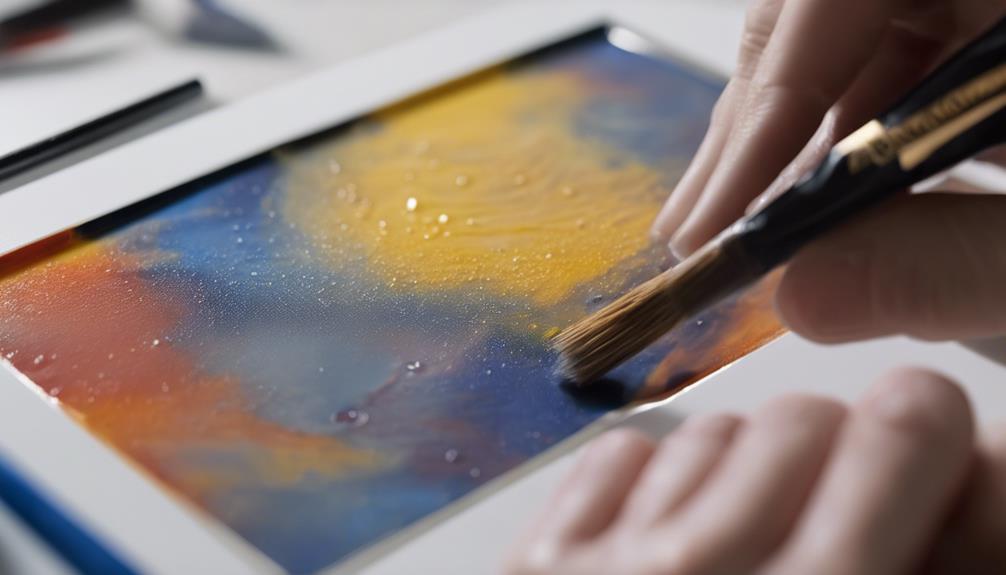
To protect and enhance the painted plastic frame, we recommend sealing it with polyurethane, a clear and durable sealant. Applying polyurethane over the painted surface not only provides protection against scratches, moisture, and UV rays but also helps to prolong the lifespan of the paint.
When selecting polyurethane, consider the different finishes available, such as matte, satin, semi-gloss, or glossy, to achieve the desired look for your frames.
To apply polyurethane effectively, make sure that the painted plastic frame has already received a coat of primer and is completely dry. Use a high-quality brush or foam applicator to apply thin and smooth coats of polyurethane to avoid streaks or bubbles. Allow each coat to dry thoroughly before adding additional layers.
Frequently Asked Questions
How to Paint a Plastic Frame?
When painting a plastic frame, proper preparation is essential. Sand the surface lightly and clean it with rubbing alcohol for better adhesion. Use a primer specifically formulated for plastic to make sure the paint sticks well.
Apply multiple thin coats of paint, allowing each layer to dry completely before adding more. Consider adding unique touches like stamps or antiquing for a personalized look.
Following these steps will result in a beautifully painted plastic frame.
What Paint to Use on Plastic Frames?
When painting plastic frames, it's important to select the right type of paint for excellent adhesion and durability. Utilizing paints specifically formulated for plastics guarantees a lasting finish.
Look for spray paints or brush-on craft paints labeled for plastic use. Consider using a plastic primer if the desired color is unavailable in the chosen paint type.
Adhering to these guidelines guarantees a successful painting project with vibrant and long-lasting results.
What Kind of Paint Will Stick to Plastic?
When considering what kind of paint will stick to plastic, it's important to choose a paint specifically designed for plastic surfaces. Regular brush-on or spray-on paints may not adhere well, leading to peeling or chipping.
Opt for spray paint formulated for plastic or use a plastic primer before painting to guarantee better adhesion. Acrylic craft paint can also be suitable for decorative purposes, but for a long-lasting finish, selecting the right plastic-specific paint is essential.
How Do You Prep Plastic for Paint?
When prepping plastic for paint, we must start by thoroughly cleaning the surface to remove any debris.
Light sanding helps the paint adhere better, and wiping with rubbing alcohol guarantees a clean canvas for painting.
Masking off areas we don't want to paint is vital.
Applying a suitable primer designed for plastic promotes paint adhesion and a smooth finish.
These steps are essential to achieve a professional-looking paint job on plastic surfaces.
Conclusion
In just 10 simple steps, you can transform a plain plastic frame into a personalized work of art.
By following these easy instructions, you can create a unique and custom piece that reflects your style and creativity.
So grab your supplies and get painting – the possibilities are endless!
- About the Author
- Latest Posts
Introducing Ron, the home decor aficionado at ByRetreat, whose passion for creating beautiful and inviting spaces is at the heart of his work. With his deep knowledge of home decor and his innate sense of style, Ron brings a wealth of expertise and a keen eye for detail to the ByRetreat team.
Ron’s love for home decor goes beyond aesthetics; he understands that our surroundings play a significant role in our overall well-being and productivity. With this in mind, Ron is dedicated to transforming remote workspaces into havens of comfort, functionality, and beauty.
Decor
How to Paint a Mirror Like a Pro in 3 Easy Steps
Find out how to transform your mirror into a masterpiece with these three easy steps that will elevate your space instantly.

Painting a mirror like a pro is simple in three steps. First, clean and trace the frame, then prime with gesso. Apply paint from the edges in thin layers using quality brushes. Opt for enamel or acrylic paint, allowing thorough drying between coats. Finish with sealant for protection. This process guarantees a flawless, professional look that enhances any space with elegance and style. Mastering these steps will help create a polished finish that transforms your mirror into a work of art.
Key Takeaways
- Use high-quality enamel or acrylic paint for a professional finish.
- Apply thin, even layers starting from the edges.
- Allow each coat to dry completely before adding another.
- Finish with a sealant or varnish for protection and longevity.
- Focus on details and take your time for a polished result.
Prepare Mirror Frame
Let's begin by cleaning the mirror frame with a soft cloth and window cleaner to remove any dirt or residue. Make sure to use rubbing alcohol or vinegar for tougher areas, guaranteeing the surface is completely clean before starting the painting process.
Once clean, trace the area to be painted on the mirror frame using a white soluble pencil for precise painting boundaries. This step is essential in achieving a clean and professional look for your mirror project.
Next, seal the mirror frame with white gesso as a primer to prevent paint peeling and ensure long-lasting results. This will create a smooth surface for the paint to adhere to, enhancing the durability of your design.
Additionally, consider using makeup pencils, white crayons, or fabric pencils for tracing intricate designs on the mirror frame before painting to achieve a detailed and polished final look. Make sure to take your time during this preparation process to guarantee a high-quality finish for your mirror frame project.
Apply Paint Evenly

To guarantee a smooth and professional finish, apply the paint evenly on the mirror surface using a high-quality paintbrush.
Here are some key tips to help you achieve a flawless coat of paint on your mirror:
- Start painting from the edges: Begin by carefully painting along the edges of the mirror frame before moving towards the center. This method ensures a consistent application and helps prevent any uneven patches.
- Work in thin layers: Avoid applying thick coats of paint as this can lead to drips and streaks on the mirror surface. Instead, opt for multiple thin layers, allowing each coat to dry completely before adding another one.
- Use a steady hand: When applying the paint, maintain a light touch and steady hand to achieve an even finish. This technique helps in creating a uniform look across the entire mirror.
Achieve Professional Finish
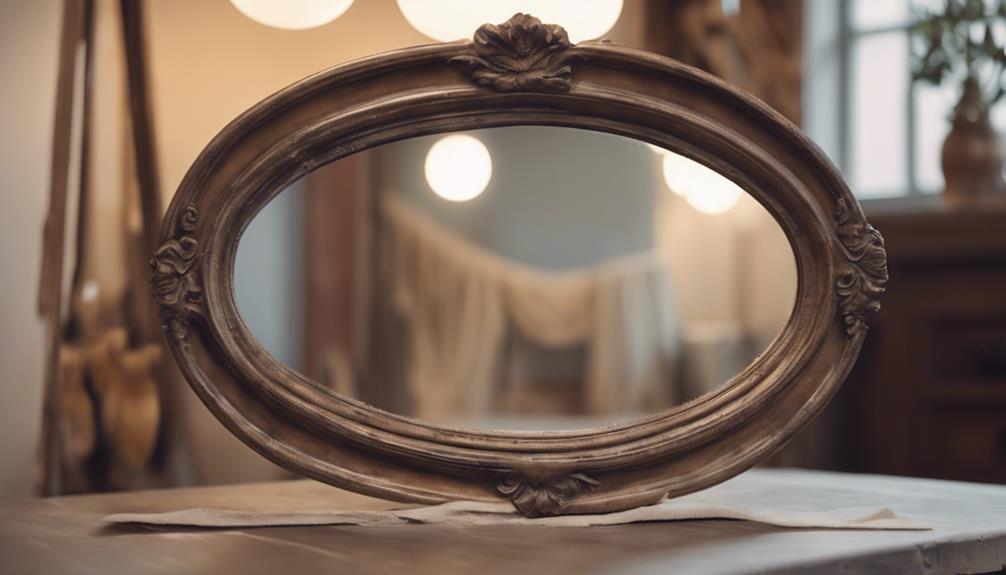
For a professional finish when painting a mirror, select high-quality enamel or acrylic paint specifically formulated for glass surfaces. To achieve a polished look, it is vital to apply thin coats of paint in even layers, allowing each coat to dry thoroughly before adding the next. This process guarantees a smooth and professional result on your painted mirror surface. Additionally, consider applying a sealant or varnish to protect the painted surface and enhance its longevity. Taking your time and paying attention to details will help you safeguard the painted surface and achieve a polished finish.
| Key Steps to Achieve Professional Finish |
|---|
| Choose high-quality enamel or acrylic paint designed for glass surfaces |
| Apply thin coats in even layers |
| Allow drying time between coats |
Frequently Asked Questions
How to Do Mirror Painting?
When tackling mirror painting, selecting the correct acrylic paint designed for glass surfaces is crucial. By seeking inspiration from TikTok artists, applying thin layers of paint, and ensuring each coat is dry before adding another, you can achieve a professional finish.
Seal the painted mirror with a varnish or sealant for durability. Experimenting with different painting styles and techniques is crucial for crafting a unique and creative mirror design.
How to Paint a Mirror to Look Vintage?
When aiming to paint a mirror for a vintage appearance, we recommend utilizing chalk paint for its ability to achieve a classic look.
Lightly sanding the frame before painting can enhance the vintage effect, while distressing techniques like dry brushing or layering can contribute to an aged appearance.
Consider applying dark wax or antiquing glaze to develop a vintage patina, resulting in a weathered finish that exudes a timeless charm.
How to Get Mirror Finish When Painting?
To achieve a mirror finish when painting, it's essential to use a high-quality mirror-specific paint. Make sure the mirror surface is thoroughly clean and free of any debris to prevent imperfections.
Apply thin, even coats of paint to avoid drips and streaks that can compromise the mirror-like appearance. Consider using spray paint for a more uniform finish and to prevent brush strokes.
Allow adequate drying time between coats for a flawless mirror-like finish.
How Do You Paint a Mirror Without Getting Paint on the Mirror?
When painting a mirror, we implement a meticulous approach to prevent any unwanted paint mishaps.
Careful preparation, like using painter's tape and paper to shield the mirror, is crucial. Selecting the appropriate paint type for the frame minimizes the risk of paint reaching the mirror.
Applying paint with precision and swiftly addressing any accidental spills on the mirror guarantees a flawless finish. Patience and attention to detail are key elements in achieving a polished result.
Conclusion
To sum up, painting a mirror like a pro may seem simple, but achieving that flawless finish requires attention to detail and patience.
So next time you pick up that paintbrush, remember to take your time and follow these steps carefully.
And who knows, maybe your mirror will reflect not just your image, but also your newfound painting skills.
Happy painting!
- About the Author
- Latest Posts
Introducing Ron, the home decor aficionado at ByRetreat, whose passion for creating beautiful and inviting spaces is at the heart of his work. With his deep knowledge of home decor and his innate sense of style, Ron brings a wealth of expertise and a keen eye for detail to the ByRetreat team.
Ron’s love for home decor goes beyond aesthetics; he understands that our surroundings play a significant role in our overall well-being and productivity. With this in mind, Ron is dedicated to transforming remote workspaces into havens of comfort, functionality, and beauty.
-

 Vetted3 weeks ago
Vetted3 weeks ago15 Best Contact Paper for Kitchen Cabinets to Elevate Your Home Decor
-

 Vetted2 weeks ago
Vetted2 weeks ago15 Best Poe Cameras for Home Security – Reviews & Buying Guide
-

 Vetted4 weeks ago
Vetted4 weeks ago15 Best Leather Restorer Products to Revive Your Furniture and Accessories
-

 Vetted3 weeks ago
Vetted3 weeks ago15 Best Drain Snakes to Unclog Your Pipes Like a Pro
-

 Beginners Guides4 days ago
Beginners Guides4 days agoI Inhaled Vinegar Fumes
-

 Vetted4 weeks ago
Vetted4 weeks ago14 Best Stationery Brands for Your Next Writing Adventure
-

 Beginners Guides2 weeks ago
Beginners Guides2 weeks agoSwinger Porch Light Color
-

 Mardi Gras Decoration3 weeks ago
Mardi Gras Decoration3 weeks agoWhy Does Hobby Lobby Not Do Mardi Gras?

























